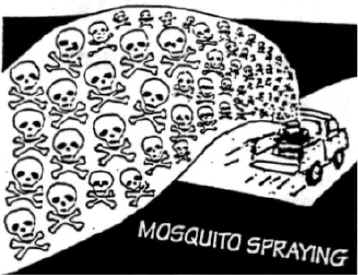 |
No Spray News James Irwin |
 |
No Spray News James Irwin |
March 11, 2002 Page 7
| Chemical and Biological Terrorism | By Vaughn E.
Wagner, Ph.D., B.C.C., M.E. |
One of the principal advantages of chemical and bioterrorism acents is their extreme toxicity in small quantities. These agents must have the ability to form and be delivered in respirable aerosol concentrations (10 Ám or less) to result in mass casualties. The settling rate of aerosol droplets of this size proceeds very slowly and will drift for enormous distances at low wind speeds. Consequently, the ability of chemical and biological acents to generate aerosol droplet clouds is a necessity in order to be effective.
Bacilliis thuringiensis (BT) strains have wide use as an agricultural and public health (mosquitoes, black flies) insecticide. The BT organism and its delta-endotoxin toxin adversely affect the targeted insect and effectively control the pest. BT is not a human pathogen. However, BT is closely related to the anthrax organism B. anthracis. BT is also a spore-former whose parasporal bodies are cuboid or diamond shaped as opposed to anthrax's cylindrical or oval spores. BT is mass-produced in the US by a fermentation process. The resultant crystalline spores and delta-endotoxin are formlated as liquid concentrates, powders, or granules.
The concern from a terrorist standpoint is that spray and granular equipment designed for BT dispersion could be easily adapted to a bioaerosol dispersion of anthrax spores. Also BT formulations could be contaminated by anthrax and applied by air or ground spray equipment used in mosquito control and agricultural pest activities. This is particularly relevant to populated areas, as mosquito control is usually conducted in highly urbanized or recreational areas.
http://www.pep.bc.ca/hazard_preparedness/terrorism_consequences.html
Sprayed Biological Agents Invade Residences
Abstract for Kay Teschke. "Spatial
& Temporal Distribution of Airborne BT..."
Environmental Health Perspectives vol. 109, No. 1. Jan. 2001
We measured airborne exposures to the biological insecticide Bacillus thuringiensis var. kurstaki (Btk) during an aerial spray program to eradicate gypsy moths on the west coast of Canada. We aimed to determine whether staying indoors during spraying redued exposures, to determine the rate of temporal decay of airborne concentrations, and to determine whether drift occurred outside the spray zone. During spraying, the average culturable airborne Btk concentration measured outdoors within the spray zone was 739 colony-forming units (CFU)/m3 of air. Outdoor air concentrations decreased over time, quickly in an initial phase with a half time of 3.3 hr, and then more slowly over the following 9 days, with an overall half-time of about 2.4 days. Inside residences during spraying, average concentrations were initially 2-5 times lower than outdoors, but at 5-6 hr after spraying began, indoor concentrations exceeded those outdoors, with an average of 244 CFU/m3 vs. 77 CFU/m3 outdoors, suggesting that the initial benefits of remaining indoors during spraying may not persist as outside air moves indoors with normal daily activities. There was drift of culturable Btk throughout a 125- to 1,000- meter band outside the spray zone where measurements were made, a consequence of the fine aerosol sizes that remained airborne (count median diameters of 4.3 to 7.2 Ám). Btk concentrations outside the spray zone were related to wind speed and direction, but not to distance from the spray zone.
http://ehpnet1.niehs.nih.gov/docs/2001/109p47-54teschke/abstract.html